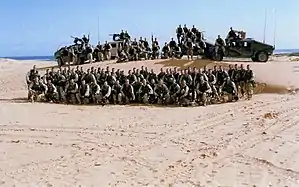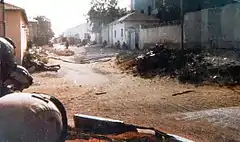Operation Gothic Serpent
Operation Gothic Serpent was a military operation conducted by United States special operations forces during the Somali Civil War with the primary mission of capturing faction leader Mohamed Farrah Aidid. The operation occurred in Somalia from August to October 1993 and was supervised by the Joint Special Operations Command (JSOC).
| Operation Gothic Serpent | |||||||
|---|---|---|---|---|---|---|---|
| Part of the Somali Civil War and the UNOSOM II mission | |||||||
 B Company, 3rd Battalion, 75th Ranger Regiment in Somalia, 1993. | |||||||
| |||||||
| Belligerents | |||||||
|
|
Supported by: | ||||||
| Commanders and leaders | |||||||
|
|
| ||||||
| Strength | |||||||
| 30,000+ all five U.N. nations | Around 4,000–6,000+ militia mixed with civilian fighters | ||||||
| Casualties and losses | |||||||
|
94 wounded 1 captured |
500-1,000 killed 1,000–3,000 wounded 22 captured (2 key targets included) | ||||||
As part of the operation, the soldiers were deployed in a mission to arrest two of Aidid's lieutenants. That mission's result – executed under the command of Gothic Serpent – became known as the Battle of Mogadishu.
Background
In December 1992, U.S. President George H. W. Bush ordered the U.S. military to join the U.N. in a joint operation known as Operation Restore Hope, with the primary mission of restoring order in Somalia. The country was racked by civil war and a severe famine as it was ruled by a number of faction leaders. Over the next several months, the situation deteriorated.
On 20 January 1993, Bush's successor, Bill Clinton, took office.
In May 1993, all the parties involved in the civil war agreed to a disarmament conference proposed by the leading Somali faction leader, Mohamed Farrah Aidid. The Somali National Alliance had been formed in June 1992. This alliance consisted of faction leaders across the country, operating under Aidid's authority, Aidid having declared himself Somalia's president. A great number of Somali civilians also resented the international forces, leading many, including women and children, to take up arms and actively resist U.S. forces during fighting in Mogadishu.
On 5 June 1993, one of the deadliest attacks on U.N. forces in Somalia occurred when 24 Pakistani soldiers were ambushed and killed in an Aidid-controlled area of Mogadishu.
Any hope of a peaceful resolution of the conflict quickly vanished. The next day, the U.N. Security Council issued Resolution 837, calling for the arrest and trial of those that carried out the ambush. U.S. warplanes and U.N. troops began an attack on Aidid's stronghold. Aidid remained defiant, and the violence between Somalis and U.N. forces escalated.
Task Force Ranger
On 8 August 1993, Aidid's militia detonated a remote controlled bomb against a U.S. Army vehicle, killing four Military Police soldiers. Two weeks later, another bomb injured seven more.[1] In response, President Clinton approved the proposal to deploy a special task force, composed of 400 U.S. Army Rangers and Delta Force operators.[2] This unit, named Task Force Ranger, consisted of 160 elite U.S. troops. They flew to Mogadishu and began a manhunt for Aidid.
On 22 August, the force was deployed to Somalia under the command of Major General William F. Garrison, JSOC's commander at the time.
The force consisted of:
- B Company, 3rd Battalion, 75th Ranger Regiment
- C Squadron, 1st Special Forces Operational Detachment-Delta (1st SFOD-D)
- A deployment package of 16 helicopters and personnel from the 160th Special Operations Aviation Regiment (160th SOAR), which included MH-60 Black Hawks and AH/MH-6 Little Birds.
- Navy SEALs from the Naval Special Warfare Development Group (DEVGRU)
- Air Force Pararescuemen and Combat Controllers from the 24th Special Tactics Squadron.[3]
General situation
In Mogadishu, the task force occupied an old hangar and construction trailers under primitive conditions. The force lacked on-site potable water and was subject to frequent mortar fire.
During September, the force conducted several successful missions to arrest sympathizers and to confiscate arms caches. The aircraft also made frequent flights over the city to desensitize the public to the presence of military aircraft and to familiarize themselves with the city's narrow streets and alleys (see PSYOPs).
On 21 September, the force captured Aidid's financier, Osman Ali Atto, when a Delta team intercepted a vehicle convoy transporting him out of the city.
At approximately 0200 on 25 September, Aidid's men shot down a Black Hawk with an RPG and killed three crew members at New Port near Mogadishu. Although the helicopter was not part of a Task Force Ranger mission, the Black Hawk destruction was a huge SNA psychological victory.[4][5]
Battle of Mogadishu

On the afternoon of 3 October 1993, informed that two leaders of Aidid's clan were at a residence in the "Black Sea" neighborhood in Mogadishu,[6] the task force sent 19 aircraft, 12 vehicles, and 160 men to arrest them. During the mission, Private Todd Blackburn (who, contrary to the film adaptation of the events, arrived in Somalia at the same time as the rest of the 75th Ranger Regiment) missed the rope while fast-roping from an MH-60 Black Hawk helicopter. He fell 70 feet to the street below, badly injuring himself.
The two Somali leaders were quickly arrested. The prisoners and Blackburn were loaded on a convoy of ground vehicles. However, armed militiamen and civilians, some of them women and children, converged on the target area from all over the city. Sergeant Dominick Pilla and a Somali combatant spotted each other and fired at the same time. Both were killed. The operation's commanders were stunned to hear that a soldier had been killed, as they expected no casualties during the operation. During the battle's first hours, a MH-60 Black Hawk, Super Six One, piloted by Cliff Wolcott, was shot down by a Somali combatant using a rocket-propelled grenade (RPG). Both of the pilots were killed, but the crew survived the crash landing.
Later, another Black Hawk helicopter, Super Six Four, was shot down by an RPG fired from the ground. No rescue team was immediately available, and the small surviving crew, including one of the pilots, Michael Durant, couldn't move. Two Delta snipers – Master Sergeant Gary Gordon and Sergeant First Class Randy Shughart provided cover from a helicopter, and repeatedly volunteered to secure the crash site. On their third try, they were given permission, both men aware that it would probably cost them their lives. When they arrived, they attempted to secure the site, but Gordon was killed, leaving only Durant and Shughart. Eventually, after holding off and killing more than 25 Somalis, Shughart was killed and Durant taken hostage. Shughart and Gordon were both posthumously awarded the Medal of Honor for their actions.
Meanwhile, the remaining Rangers and Delta operators fought their way to the first crash site, where they found the crew. They soon found themselves surrounded by Somali Habr Gidr militia. The Somali commander, Colonel Sharif Hassan Giumale, decided to kill the U.S. troops with mortar fire, and Somali militia prepared to bombard the besieged Americans with 60mm mortars. However, Colonel Giumale called off the mortar strike after information of possible civilian hostages arose. Repeated attempts by the Somalis to overrun U.S. positions were beaten back with heavy small arms fire accompanied by strafing and rocket fire from helicopters. A rescue convoy was organized, made up of the U.S. Army's 10th Mountain Division and Malaysian and Pakistani forces. In heavy combat with the Somalis, the rescue convoy broke through the encirclement and rescued the besieged forces.
The mission's objective of capturing Aidid's associates was accomplished, but the battle turned out to be the most difficult close combat that U.S. troopers had engaged in since the Vietnam War. In the end, two MH-60 Black Hawks were shot down, another was seriously damaged, and 18 U.S. troopers and both a Malaysian and a Pakistani soldier on the rescue convoy were killed, and 82 were wounded. Estimates of Somali fatalities are around 1,000 militiamen killed during the battle, with over 3,000 wounded.
6 October mortar attack
Two days after the battle's end, Somali militiamen launched a mortar strike on a U.S. compound that killed Delta operator Sergeant First Class Matt Rierson and injured another 12 Delta operators.
U.S. withdrawal
Following the battle, President Clinton ordered that additional troops be added to protect U.S. soldiers and aid in withdrawal. Clinton called for a full withdrawal by 31 March 1994. Conforming to this request, most troops were out of the country by 25 March 1994. A few hundred U.S. Marines remained offshore, but all U.S. and United Nations troops were finally removed from the area at the conclusion of Operation United Shield in March 1995.[7]
Legacy
U.S. Secretary of Defense Les Aspin resigned his post late in 1993. He was specifically blamed for denying the U.S. Army permission to have its own armor units in place in Somalia, units which might have been able to break through to the trapped soldiers earlier in the battle. U.S. political leaders thought the presence of tanks would spoil the peacekeeping image of the mission.[7]
Osama bin Laden, who was living in Sudan at the time, cited this operation, in particular U.S. withdrawal, as an example of American weakness and vulnerability to an attack.
In popular culture
- The battle is portrayed in the book Black Hawk Down, the film of the same name, the NovaLogic video game Delta Force: Black Hawk Down, the board wargame Lock 'n Load: A Day of Heroes, and in Howard E. Wasdin's autobiography, SEAL Team Six.
References
- Bowden, Mark (1999). Black Hawk Down: A Story of Modern War. New York: Signet. p. 114. ISBN 978-0802144737.
- Brune, Lester H. (1999) The United States and Post-Cold War Interventions, Regina Books, ISBN 0941690903 p. 31
- Bailey, Tracy A (6 October 2008). "Rangers Honor Fallen Brothers of Operation Gothic Serpent". ShadowSpear Special Operations. Archived from the original on 4 March 2010. Retrieved 13 October 2008.
- Bowden 1999 pp.133.
- Chun, Clayton K.S. (2012). Gothic Serpent: Black Hawk Down, Mogadishu 1993. Osprey Raid Series #31. Osprey Publishing. p. 32.
- Clinton, Bill. My Life. New York: Knopf, 2004.
- Stewart, Richard W. (24 February 2006). "The United States Army in Somalia, 1992–1994". United States Army Center of Military History. United States Military. Retrieved 4 December 2009.
Bibliography
- Allard, Colonel Kenneth, Somalia Operations: Lessons Learned, National Defense University Press (1995).
- Dolan, Ronald E. A History of the 160th Special Operations Aviation Regiment (Airborne), Chapter IX: Somalia/Operation Gothic Serpent. Washington, DC: Federal Research Division, Library of Congress. October 2001.
- Loeb, Vernon. The CIA in Somalia: After-Action Report. Washington: Washington Post Magazine. 27 February 2000.
- Chun, Clayton K.S., Gothic Serpent: Black Hawk Down, Mogadishu 1993. Osprey Raid Series #31. Osprey Publishing (2012). ISBN 978-1849085847